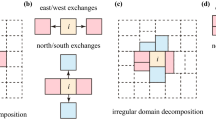Abstract
Domain-specific programming frameworks are usually effective to simplify the development of large-scale applications on supercomputers. This paper introduces a parallel programming framework named JCOGIN for particle transport on combinatorial geometry. JCOGIN provides a combinatorial geometry data model and a patch-based parallel computing model to manage the data distribution in parallel computing and implements the hybrid parallelism of the domain decomposition and the particle parallelism on MPI/OpenMP to overcome the bottleneck of huge memory demand and long computational time. The application programming interface of JCOGIN can support users to quickly develop their parallel particle transport applications. Based on this framework, users only need to write serial codes for large-scale numerical simulations on modern supercomputers. The parallel efficiency of applications based on JCOGIN can reach up to 80% on hundreds of thousands of CPU cores.

















Similar content being viewed by others
References
Hoogenboom JE, Martin WR, Petrovic B (2011) Monte Carlo performance benchmark for detailed power density calculation in a full size reactor core. Benchmark specifications revision 1.2 (2011). http://www.oecd-nea.org/dbprog/MonteCarloPerformanceBenchmark.htm
Leppänen J, Mattila R (2016) Validation of the Serpent-ARES code sequence using the MIT BEAVRS benchmark—HFP conditions and fuel cycle 1 simulations. Ann Nucl Energy 96:324–331
Liu S, Liang J, Wu Q et al (2017) BEAVRS full core burnup calculation in hot full power condition by RMC code. Ann Nucl Energy 101:434–446
Gunow G, Forget B, Smith K (2019) Full core 3D simulation of the BEAVRS benchmark with OpenMOC. Ann Nucl Energy 134:299–304
Horelik N, Siegel A, Forget B et al (2014) Monte Carlo domain decomposition for robust nuclear reactor analysis. Parallel Comput 40(10):646–660
Johansen H, McInnes LC et al (2014) Software productivity for extremescale science. DOE Workshop Report, Rockville MD
Mo Z, Zhang A, Cao X et al (2010) JASMIN: a parallel software infrastructure for scientific computing. Front Comput Sci China 4(4):480–488
Amarasinghe S, Hall M, Lethin R et al (2011) ASCR programming challenges for exascale computing. Workshop on Exascale Programming Challenges, Marina del Rey pp 27–29
Dubey A et al (2014) A survey of high level frameworks in block-structured adaptive mesh refinement packages. J Parallel Distrib Comput 74(12):3217–3227
SAMRAI (2018) https://computation.llnl.gov/project/SAMRAI/. Accessed 15 Dec 2018
Unitah (2018) http://uintah.utah.edu/. Accessed 15 Dec 2018
Stewart JR, Edwards HC (2003) The SIERRA framework for developing advanced parallel mechanics applications. Large Scale PDE Constr Optim 30:301–315
SIERRA (2018) https://sierradist.sandia.gov. Accessed 15 Dec 2018
UG (2018) https://gcsc.uni-frankfurt.de/simulation-and-modelling/ug4. Accessed 15 Dec 2018
PUMI (2018) https://www.scorec.rpi.edu/pumi/. Accessed 15 Dec 2018
PHG (2018) http://lsec.cc.ac.cn/phg/index.htm. Accessed 15 Dec 2018
Mo Z, Zhang A, Liu Q, Cao X (2016) Parallel algorithm and parallel programming: from specialty to generality as well as software reuse. Sci Sin Inf 46(10):1392–1410
JASMIN (2020) http://www.caep-scns.ac.cn/JASMIN.php. Accessed 10 June 2020
Liu Q, Zhao W, Cheng J, Mo Z, Zhang A, Liu J (2016) A programming framework for large scale numerical simulations on unstructured mesh. IEEE HPSC2016, pp 310–315
JAUMIN (2020) http://www.caep-scns.ac.cn/JAUMIN.php. Accessed 10 June 2020
Allison J (2006) Geant4 developments and applications. IEEE Trans Nucl Sci 53(1):270–278
Amadio G, Apostolakis J, Bandieramonte M et al (2015) The GeantV project: preparing the future of simulation. J Phys Conf Ser 664(7):072006
Canal P, Sexton-Kennedy E, Madsen J et al (2020) Geant exascale pilot project. Eur Phys J Conf 245(3):09015
Giménez-Alventosa V, Giménez Gómez V, Oliver Gil S (2020) PenRed: an extensible and parallel Monte-Carlo framework for radiation transport based on PENELOPE. arXiv:2003.00796v2
Salvat F (2019) PENELOPE-2018: a code System for Monte Carlo Simulation of Electron and Photon Transport. OECD/NEA Data Bank, Issyles-Moulineaux, France
JCOGIN (2020) http://www.caep-scns.ac.cn/JCOGIN.php. Accessed 10 June 2020
Zhang B, Li G, Deng L et al (2014) JCOGIN: a parallel programming infrastructure for Monte Carlo particle transport. PHYSOR 2014—the role of reactor physics toward a sustainable future, The Westin Miyako, Kyoto, Japan
Deng L, Li G, Zhang B et al (2013) Simulation of the full-core pin-model by JMCT Monte Carlo neutron–photon transport code. M&C 2013, Sun Valley, Idaho, pp 427–433
Tu X, Liu D, Wang X et al (2020) Parallel development of MOC module in KYLIN-II code on parallel framework. Nucl Power Eng 41(S1):18–21
HDF5 (2014) http://www.hdfgroup.org/HDF5/. Accessed 11 Nov 2014
Procassini R, Cullen D, Greenman G et al (2007) New capabilities in MERCURY: a modern, Monte Carlo particle transport code. M&C+SNA, Monterey California
Li G, Zhang B, Deng L et al (2013) Development of Monte Carlo particle transport code JMCT. High Power Laser Particle Beams 25(1):158–162
Remec I, Kam FBKHB (1998) Robinson-2 pressure vessel benchmark. Office of Scientific & Technical Information Technical Reports
Zheng Z, Mei Q, Deng L et al (2018) Application of a global variance reduction method to HBR-2 benchmark. Nucl Eng Des 326:301–310
Fu Y, Ma Y, Shang G et al (2014) Sophisticated modeling and calculation of Daya Bay nuclear power station reactor based on JMCT. Nuclear Power Eng S2:239–241
Horelik N, Herman B, Forget B, Smith K (2013) Benchmark for evaluation and validation of reactor simulations (BEAVRS), v1.0.1. In: Proceedings of international conference mathematics and computational methods applied to nuclear science and engineering, Sun Valley, Idaho
Park HJ, Lee HC, Shim HJ et al (2016) Real variance analysis of Monte Carlo eigenvalue calculation by McCARD for BEAVRS benchmark. Ann Nucl Energy 90:205–211
Deng L, Li G, Zhang B et al (2017) JMCT Monte Carlo simulation analysis of BEAVRS and SG-III shielding. EPJ Web of Conferences 153:06017. https://doi.org/10.1051/epjconf/201715306017
Zhang M, Ma C, Zeng X et al (2018) Core design for radioisotope production in PWR nuclear power plant. At Energy Sci Technol 52:112–117
Acknowledgements
This paper is supported by National Key Research and Development Program of China (2016YFB0201303), Defense Industrial Technology Development Program (C1520110002), and National Natural Science Foundation of China (11805017).
Author information
Authors and Affiliations
Corresponding author
Additional information
Publisher's Note
Springer Nature remains neutral with regard to jurisdictional claims in published maps and institutional affiliations.
Rights and permissions
About this article
Cite this article
Zhang, B., Mo, Z., Wang, X. et al. JCOGIN: a programming framework for particle transport on combinatorial geometry. J Supercomput 77, 11270–11287 (2021). https://doi.org/10.1007/s11227-021-03711-w
Accepted:
Published:
Issue Date:
DOI: https://doi.org/10.1007/s11227-021-03711-w




